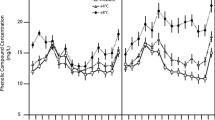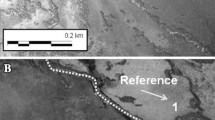Abstract
Aims
Global change is shown to significantly affect the C storage function of peatlands; however, a majority of previous research is focused on a single environmental stressor such as the increased temperature. As a result, little is known about the interactive effect of multiple environmental stressors on peatland C storage, especially in sedge-dominated fen peatlands.
Methods
We performed a full factorial experiment of increased temperature and elevated atmospheric CO2 concentration on minerotrophic, sedge-dominated fen monoliths to experimentally examine the individual and interactive effects of simulated future climate conditions on peatland plant biomass, CO2 exchange, and pore water dissolved organic carbon (DOC) over one full growing season.
Results
Our study demonstrates that warming and elevated atmospheric CO2 significantly increased aboveground and belowground biomass, respectively, as well as the gross ecosystem production (GEP), while the DOC concentrations and respired CO2 from peatland soils only increased under warming
Conclusions
Our results suggest that global change will increase both plant production and microbial decomposition, but with altered plant biomass allocation between aboveground and belowground. Our study provides experimental evidence for shifts in ecosystem-level carbon dynamics under global change for a sedge-dominated peatland, and suggests that while carbon stores may weaken, the carbon sink will be maintained in these types of northern peatlands if hydrological conditions are largely maintained.


Similar content being viewed by others
References
Basiliko N, Stewart H, Roulet NT, Moore TR (2012) Do root exudates enhance peat decomposition? Geomicrobiol J 29:374–378
Berendse F, van Breemen N, Rydin H, Buttler A, Heijmans M, Hoosbeek MR et al (2001) Raised atmospheric CO2 levels and increased N deposition cause shifts in plant species composition and production in Sphagnum bogs. Glob Chang Biol 7:591–598
Bridgham SD, Pastor J, Dewey B, Weltzin JF, Updegraff K (2008) Rapid carbon response of peatlands to climate change. Ecology 89:3041–3048
Carey JC, Tang J, Templer PH, Kroeger KD, Crowther TW, Burton AJ et al (2016) Temperature response of soil respiration largely unaltered with experimental warming. Proc Natl Acad Sci USA 113:13797–13802
Chapin FS III, Shaver GR (1996) Physiological and growth responses of arctic plants to a field experiment simulating climatic change. Ecology 77:822–840
Crow SE, Wieder RK (2005) Source of CO2 emission from a northern peatland root respiration exudation and decomposition. Ecology 86:1825–1834
Davidson EA, Janssens IA (2006) Temperature sensitivity of soil carbon decomposition and feedbacks to climate change. Nature 440:165–173
Del Giudice R, Lindo Z (2017) Short-term leaching dynamics of three peatland plant species reveals how shifts in plant communities may affect decomposition processes. Geoderma 285:110–116
Dieleman CM, Branfireun BA, McLaughlin JW, Lindo Z (2015) Climate change drives a shift in peatland ecosystem plant community: implications for ecosystem function and stability. Glob Chang Biol 21:388–395
Dieleman CM, Lindo Z, McLaughlin JW, Craig AE, Branfireun BA (2016) Climate change effects on peatland decomposition and porewater dissolved organic carbon biogeochemistry. Biogeochemistry 128:385–396
Dorrepaal E, Toet S, van Logtestijn RSP, Swart E, van de Weg MJ, Callaghan TV et al (2009) Carbon respiration from subsurface peat accelerated by climate warming in the subarctic. Nature 460:616–619
Environment Canada (2010) Canadian climate normals 1981–2010 station data: Wawa A station, Ontario. Retrieved from http://climate.weather.gc.ca/climate_normals/results_1981_2010_e.html?searchType=stnName&txtStationName=Wawa&searchMethod=contains&txtCentralLatMin=0&txtCentralLatSec=0&txtCentralLongMin=0&txtCentralLongSec=0&stnID=4099&dispBack=1
Faubert P, Rochefort L (2002) Response of peatland mosses to burial by wind-dispersed peat. Bryologist 105:96–103
Fenner N, Ostle NJ, McNamara N, Sparks T, Harmens H, Reynolds B et al (2007) Elevated CO2 effects on peatland plant community carbon dynamics and DOC production. Ecosystems 10:635–647
Freeman C, Evans CD, Monteith DT, Reynolds B, Fenner N (2001) Export of organic carbon from peat soils. Nature 412:785
Freeman C, Fenner N, Ostle NJ, Kang H, Dowrick DJ, Reynolds B et al (2004) Export of dissolved organic carbon from peatlands under elevated carbon dioxide levels. Nature 430:195–198
Gavazov K, Albrecht R, Buttler A, Dorrepaal E, Garnett MH, Gogo S et al (2018) Vascular plant-mediated controls on atmospheric carbon assimilation and peat carbon decomposition under climate change. Glob Chang Biol 24:3911–3921
Gorham E (1991) Northern peatlands role in the carbon cycle and probable responses to climatic warming. Ecol Appl 1:182–195
IPCC (2014) Climate Change 2014: Synthesis Report. Contribution of Working Groups I, II and III to the Fifth Assessment Report of the Intergovernmental Panel on Climate Change [Core Writing Team, Pachauri RK, Meyer LA (eds.)]. IPCC, Geneva, 151 pp
Jackson RB, Cook CW, Pippen JS, Palmer SM (2009) Increased belowground biomass and soil CO2 fluxes after a decade of carbon dioxide enrichment in a warm-temperate forest. Ecology 90:3352–3366
Jiang J, Huang Y, Ma S, Stacy M, Shi Z, Ricciuto DM et al (2018) Forecasting responses of a northern peatland carbon cycle to elevated CO2 and a gradient of experimental warming. J Geophys Res Biogeosci 123:1057–1071
Lafleur PM, Moore TR, Roulet NT, Frolking S (2005) Ecosystem respiration in a cool temperate bog depends on peat temperature but not water table. Ecosystems 8:619–629
Laine AM, Mäkiranta P, Laiho R et al (2019) Warming impacts on boreal fen CO2 exchange under wet and dry conditions. Glob Change Biol 25:1995–2008
Leroy F, Gogo S, Guimbaud C, Bernard-Jannin L, Hu Z, Laggoun-Défarge F (2017) Vegetation composition controls temperature sensitivity of CO2 and CH4 emissions and DOC concentration in peatlands. Soil Biol Biochem 107:164–167
Li F, Peng Y, Natali SM, Chen K, Han T, Yang G et al (2017) Warming effects on permafrost ecosystem carbon fluxes associated with plant nutrients. Ecology 98:2851–2859
Lindo Z (2015) Warming favours small-bodied organisms through enhanced reproduction and compositional shifts in belowground systems. Soil Biol Biochem 91:271–278
Lyons CL, Lindo Z (2020) Above- and belowground community linkages in boreal peatlands. Plant Ecol 221:615–632
Mäkiranta P, Laiho R, Mehtätalo L et al (2018) Responses of phenology and biomass production of boreal fens to climate warming under different water-table level regimes. Glob Change Biol 24:944–956
Moore TR, Lafleur PM, Poon DMI, Heumann BW, Seaquist JW, Roulet NT (2006) Spring photosynthesis in a cool temperate bog. Glob Chang Biol 12:2323–2335
Nichols JE, Peteet DM (2019) Rapid expansion of northern peatlands and doubled estimate of carbon storage. Nature Geosci 12:917–921
Nie M, Lu M, Bell J, Raut S, Pendall E (2013) Altered root traits due to elevated CO2: a meta-analysis. Glob Ecol Biogeogr 22:1095–1105
Phillips RP, Finzi AC, Bernhardt ES (2011) Enhanced root exudation induces microbial feedbacks to N cycling in a pine forest under long-term CO2 fumigation. Ecol Lett 14:187–194
Pregitzer KS, Zak DR, Maziasz J, DeForest J, Curtis PS, Lussenhop J (2000) Interactive effects of atmospheric CO2 and soil-N availability on fine roots of Populus tremuloides. Ecol Appl 10:18–33
Pregitzer KS, Burton AJ, King JS, Zak DR (2008) Soil respiration, root biomass, and root turnover following long-term exposure of northern forests to elevated atmospheric CO2 and tropospheric O3. New Phytol 180:153–161
Reyes-Fox M, Steltzer H, Trlica MJ, McMaster GS, Andales AA, LeCain DR et al (2014) Elevated CO2 further lengthens growing season under warming conditions. Nature 510:259–262
Richardson AD, Hufkens K, Milliman T, Aubrecht DM, Furze ME, Seyednasrollah B et al (2018) Ecosystem warming extends vegetation activity but heightens vulnerability to cold temperatures. Nature 560:368–371
Robroek BJM, Jassey VEJ, Beltman B, Hefting MM (2017) Diverse fen plant communities enhance carbon-related multifunctionality, but do not mitigate negative effects of drought. Open Science 4(10):170449–170411
Saarinen T (1996) Biomass and production of two vascular plants in a boreal mesotrophic fen. Can J Bot 74:934–938
Tarnocai C (2006) The effect of climate change on carbon in Canadian peatlands. Glob Planet Change 53:222–232
TIBCO Software Inc (2017) Statistica (version 13.3), Tulsa, OK, USA
Updegraff K, Bridgham SD, Pastor J, Weishampel P, Harth C (2001) Response of CO2 and CH4 emissions from peatlands to warming and water table manipulation. Ecol Appl 11:311–326
Walker TN, Ward SE, Ostle NJ et al (2015) Contrasting growth responses of dominant peatland plants to warming and vegetation composition. Oecologia 178:141–151
Wang P, Heijmans MMPD, Mommer L, van Ruijven J, Maximov TC, Berendse F (2016a) Belowground plant biomass allocation in tundra ecosystems and its relationship with temperature. Environ Res Lett 11:55003
Wang P, Mommer L, van Ruijven J, Berendse F, Maximov TC, Heijmans MMPD (2016b) Seasonal changes and vertical distribution of root standing biomass of graminoids and shrubs at a Siberian tundra site. Plant Soil 407:55–65
Ward SE, Ostle NJ, Oakley S, Quirk H, Henrys PA, Bardgett RD (2013) Warming effects on greenhouse gas fluxes in peatlands are modulated by vegetation composition. Ecol Lett 16:1285–1293
Weishaar JL, Aiken GR, Bergamaschi BA, Fram MS, Fujii R, Mopper K (2003) Evaluation of specific ultraviolet absorbance as an indicator of the chemical composition and reactivity of dissolved organic carbon. Enviro Sci Technol 37:4702–4708
Weltzin JF, Bridgham SD, Pastor J, Chen J, Harth C (2003) Potential effects of warming and drying on peatland plant community composition. Glob Chang Biol 9:141–151
Wiedermann MM, Nordin A, Gunnarsson U, Nilsson MB, Ericson L (2007) Global change shifts vegetation and plant-parasite interactions in a boreal mire. Ecology 88:454–464
Wu J, Roulet NT (2014) Climate change reduces the capacity of northern peatlands to absorb the atmospheric carbon dioxide: The different responses of bogs and fens. Global Biogeochem Cycles 28:1005–1024
Yu Z (2006) Holocene carbon accumulation of fen peatlands in boreal western Canada: A complex ecosystem response to climate variation and disturbance. Ecosystems 9:1278–1288
Yu ZC (2012) Northern peatland carbon stocks and dynamics: a review. Biogeosciences 9:4071–4085
Acknowledgements
We thank Faculty of Science, Western University for the use of the Biotron facilities, and the Ontario Ministry of Natural Resources and Forestry for the access to the research site and assistance on the sample collection. This work was supported by funding from NSERC (Natural Sciences and Engineering Research Council of Canada) Discovery Grants program to BB (#217046-2009).
Author information
Authors and Affiliations
Contributions
BAB and ZL designed the experiment; BAB funded the project; JT executed the experiment, collected and analyzed the data; JT and ZL wrote the first draft of the manuscript, and all authors contributed substantially to revisions.
Corresponding author
Additional information
Responsible Editor: Luca Bragazza
Publisher's note
Springer Nature remains neutral with regard to jurisdictional claims in published maps and institutional affiliations.
Electronic supplementary material
Below is the link to the electronic supplementary material.
ESM 1
(DOCX 1.24 MB)
Rights and permissions
About this article
Cite this article
Tian, J., Branfireun, B.A. & Lindo, Z. Global change alters peatland carbon cycling through plant biomass allocation. Plant Soil 455, 53–64 (2020). https://doi.org/10.1007/s11104-020-04664-4
Received:
Accepted:
Published:
Issue Date:
DOI: https://doi.org/10.1007/s11104-020-04664-4




